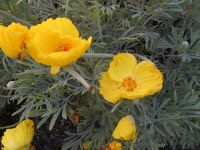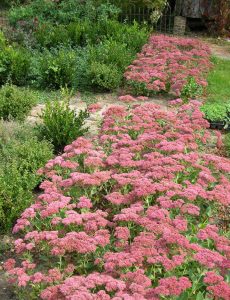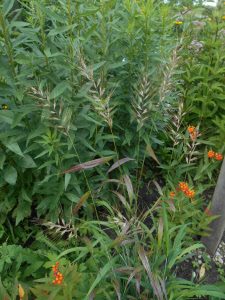Drought, Xeric & Dry Soil Plants
Showing 57–64 of 126 results
-
Hemerocallis ‘Hyperion’
Midsummer, fragrant lemon yellow trumpets
Midsummer, fragrant lemon yellow trumpets
Size: 36" x 12"
Care: Sun, moist well-drained soil. Drought tolerant.Hybrid origin, bred in 1925 and still popular today.
-
Hesperaloe parviflora Red Yucca Z 6-9
Cerise scarlet trumpets up and down the flower spike in summer
OUT OF STOCK
Cerise scarlet trumpets up and down the flower spike in summer
Size: 3’ x 5’
Care: sun moist well-drained to dry soil
Native: Europe, west & central Asia
Wildlife Value: Attracts butterflies & hummingbirds. Deer and rabbit tolerant,Named by Dr. George Engelmann, a German physician and plant fanatic who emigrated to America in the early 1800’s, settling in St. Louis.
-
Hunnemannia fumariifolia Goldencup, Mexican Tulip Poppy Z 9-11, Annual in colder areas
All summer and fall sunny, crepe-papery petals with jagged edges center around orange anthers all carried above thin-leaved blue-grey foliage.
OUT OF STOCK – EMAIL FOR AVAILABILITY
All summer and fall sunny, crepe-papery petals with jagged edges center around orange anthers all carried above thin-leaved blue-grey foliage.
Size: 6-12" x 6-12"
Care: sun in moist, well-drained to well-drained soil
Native: highlands of Mexico, TX, NM & AZDescribed and named by English botanist Robert Sweet (1783-1835) in The British Flower Garden vol. 3 (1828). Named for John Hunnemannia
-
Hydrangea arborescens ‘Annabelle’, Annabelle hydrangea, Snowball hydrangea Z 4-9
Flowering from late June to October, softball sized or bigger ivory heads fade to pale green. Toughest, easiest hydrangea to grow.
Flowering from late June to October, softball sized or bigger ivory heads fade to pale green. Toughest, easiest hydrangea to grow.
Size: 3-5’ x 3-5’
Care: Shade to sun in clay to well-drained soil. Prune back in early spring to 12-16” above the soil level.
Native: Southeastern US
Awards: Received England’s Royal Horticultural Society Award of Merit & Pennsylvania Horticultural Society Gold Medal Plant Award.Hydrangea is Greek from hydor meaning water and aggeion meaning vessel referring to the cup shaped fruit. The dried root was used as medicine – as a cathartic and diuretic. ‘Annabelle,’ the showy form, first collected around 1900 near Anna Illinois. The story of the ‘Annabelle’ hydrangea begins in southern Illinois near the town of Anna. In 1910, Harriet Kirkpatrick, went on a horseback ride along a wooded trail in Union County and noticed a beautiful native hydrangea with abnormally large, snowball-like blooms. Together with her sister-in-law, Amy Kirkpatrick, she went back to dig up the native shrub and transplant it into her yard in Anna. Neighbors and friends noticed the showy plant and the Kirkpatrick family shared specimens of the easily transplantable shrub, spreading its progeny throughout Anna and other towns in Illinois.
Given its wide local popularity, easy transplanting and culture, Mrs. Kirkpatrick contacted the Burpee Seed Company to see if there was interest in developing the new variety commercially. Unbeknownst to the Kirkpatrick’s, a recent improved cultivar of Hydrangea arborescens had been released in 1906. E. G. Hill brought the ‘Snowhill’ hydrangea into production from a wild specimen found near Yellow Springs, Ohio with similar abnormally large, snowball-like flowers, but an earlier bloom time.
So, for the next 50 years, ‘Annabelle would be an unnamed, but locally poplar cultivar, that was distributed by word of mouth throughout southern Illinois, finally reaching Urbana around 1935, based on the first recorded account.
It wasn’t until the 1960’s that the Kirkpatrick’s find gained the attention of University of Illinois professor and renowned plantsman, Dr. Joseph C. McDaniel. In 1960, McDaniel rediscovered ‘Annabelle’ by noticing it in cultivation in Urbana, IL. He traced it back to Anna, IL, collected samples for propagation, named the cultivar and released it for commercial production in 1962.
**LISTED AS OUT OF STOCK BECAUSE WE DO NOT SHIP THIS ITEM. IT IS AVAILABLE FOR PURCHASE AT OUR RETAIL LOCATION.
-
Hylotelephium herbstsfreude syn Sedum ‘Autumn Joy’ Z 4-9
Classic, large flat flower heads turn from green to rose
Classic, large flat flower heads turn from green to rose blooming in September and October. A staple for autumn in the garden.
Size: 30” x 12”
Care: full sun in well-drained soil
Wildlife Value: Attracts many bees and butterflies. Black walnut tolerant, deer resistant.
Awards: England’s Royal Horticultural Society Award of Garden Merit.Autumn Joy introduced to gardens before 1920 by the George Arends Nursery in Ronsdorf, Germany.
-
Hylotelephium sieboldii syn Sedum sieboldii, October Daphne Z 3-9
Fleshy gray-green foliage edged with pink encircles the prostrate stems, flowering strawberry pink in fall. Perfect for rock gardens, front of border, fairy gardens, roof gardens, troughs and groundcover or anyplace with drought.
Fleshy gray-green foliage edged with pink encircles the prostrate stems, flowering strawberry pink in fall. Perfect for rock gardens, front of border, fairy gardens, roof gardens, troughs and groundcover or anyplace with drought.
Size: 4" x 8"
Care: full sun in moderately fertile, well-drained soil.
Native: Japan
Wildlife Value: Drought tolerant and deer resistant.
Awards: Elisabeth Carey Miller Botanical Garden Great Plant PickSedum means “plant that sits.” “Live forever” is an ancient Greek name for sedums. The Roman Pliny claimed that sedum’s juice treated wounds. In the 1500’s English herbalist Gerard called sedums “very full of life,” referring to succulent’s quality of being very easy to grow. This species named for its discoverer, Dr. Philipp Franz von Siebold (1791-1866). Von Siebold, a German doctor, worked for the Dutch East India Company as its resident physician on Deshima Island, off the coast of Japan. He boldly became too knowledgeable about Japanese affairs and was imprisoned by the Japanese in 1826 and then banished in 1828. When he left he carried nearly 500 plants with him to Europe. William Robinson, father of the mixed perennial border, described Sedum sieboldii as beautiful. He advised gardeners to grow it “in strong loam and mortar rubble in fully exposed positions (and use it as) an excellent plant for vases in summer.”
-
Hypericum kalmianum Kalm’s St. Johns wort SHRUB Z 4-7
Eye-catching yellow saucers with a puff of showy prominent stamens in mid to late summer complimenting the glaucous blue leaves on this mounding, easy- to-grow, shrub.
Eye-catching yellow saucers with a puff of showy prominent stamens in mid to late summer complimenting the glaucous blue leaves on this mounding, easy- to-grow, shrub.
Size: 3-4’ x 3-4’
Care: sun to shade in well-drained to moist well-drained soil. Blooms on new growth so prune in late winter to early spring as far back as you wish.
Native: Quebec to WI, S. to IL, Wisconsin native.
Wildlife Value: attracts bees and butterflies
Awards: Great Plants for Great PlainsThe name Hypericum comes from Greek hyper, meaning above, and eikon, meaning icon or image. The yellow flowers of some species were placed above images to ward off evil spirits, and according to legend, Satan pierced the leaves in revenge. This species collected by and named for Peter Kalm (1716-1779), Swedish plant hunter, on his expedition in North America, 1747-1751. Offered for sale in Bartram Garden’s 1783 Broadside, America’s 1st plant catalog. David Douglas (Douglas fir guy) also collected this at Niagara Falls per British botanist William Jackson Hooker (1785-1865).
**LISTED AS OUT OF STOCK BECAUSE WE DO NOT SHIP THIS ITEM. IT IS AVAILABLE FOR PURCHASE AT OUR RETAIL LOCATION.
-
Hystrix patula syn. Elymus hystris var. hystris Bottle brush grass Z 5-9
June thru fall bears 6” long spikes looking like bottle brushes
OUT OF STOCK
June thru fall bears 6” long spikes looking like bottle brushes.
Size: 2-3’ x 12-18”
Care: sun to part shade in dry to moist well-drained soil - tolerates dry shade
Native: Nova Scotia S to Virginia, W to ND and OK. Wisconsin native
Wildlife Value: Birds eat seedsHystrix from the Greek (‘hedgehog’) meaning “with spikes” or “bristly” describing the flowers and patula means “spreading.” Collected before 1794. In 1913 L H Bailey wrote, “sometimes used for lawn decoration and for borders.”








